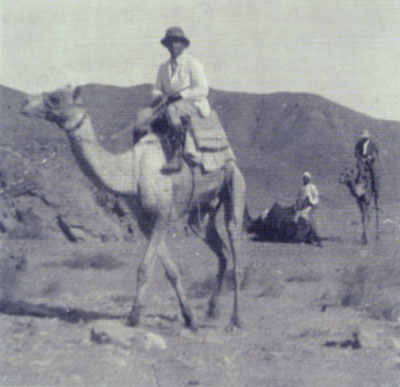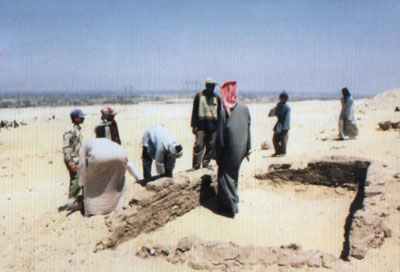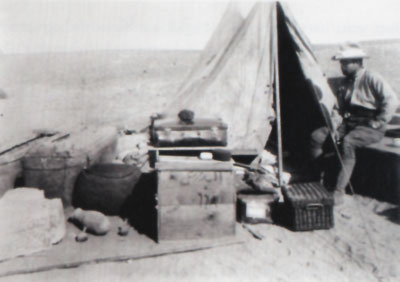
The current expedition to South Abydos follows in the footsteps of earlier explorers and archaeologists. David Randall-MacIver, Arthur C. Mace, Arthur E. P. B. Weigall, and Charles T. Currelly undertook the first archaeological investigations in the area between 1899 and 1903 on behalf of their project director, the renowned Egyptologist, William Matthew Flinders Petrie. Before discussing our new research, it is important to recognize what went before.
1899–1900: David Randall-MacIver and Arthur C. Mace
The mortuary complex of Senwosret III was first discovered late in 1899, when Randall-MacIver noticed a worked limestone block protruding from the ground. Expecting to find a small chapel, he had some men dig around it. It soon became apparent that the block was part of a doorway inside a fairly large temple dedicated to the Middle Kingdom pharaoh Senwosret III. The excavation of this temple (now known as Beautiful-is-the-Ka) occupied Randall-MacIver for the rest of the 1899–1900 field season.
At the same time, Randall-MacIver’s teammate Mace began to excavate a pyramid located about 1 km to the south of Senwosret III’s temple. Despite its relative proximity, however, they eventually realized that this pyramid was part of yet another large mortuary complex associated with a different pharaoh, the founder of the 18th Dynasty, Ahmose. That complex is now being investigated by Stephen P. Harvey of the University of Chicago.
1901–1902: Arthur E. P. B. Weigall

Two years later, Petrie had Weigall investigate the cemetery located about 1 km southwest of the temple of Senwosret III. Its main component was a great T-shaped enclosure, presumably associated with the same pharaoh. Weigall began by excavating the two prominent mud-brick structures standing in front of the enclosure. His aim was to discover the pharaoh’s tomb, but he soon decided that these were “dummy” mastaba tombs since he could find no evidence of a burial. He turned his attention next to a small brick building behind the enclosure. Confident of finding the tomb entrance here, Weigall wrote home, “We are on the eve of a great discovery.” All he found was disappointment.
Determined to find the tomb, he then began digging inside the enclosure itself. Many weeks passed as his workmen removed enormous amounts of sand from the enclosure’s vast court. At the end of the season, they finally located the entrance of a subterranean tomb cut into the bedrock. That night armed robbers tried to break into the tomb, but Weigall and his most trusted workmen bravely fought them off.
The tomb was extensive and intricate, with many features concealing passages to the burial chamber which was hidden behind a wall. Weigall did find the sarcophagus of Senwosret III, but alas it had been completely robbed in ancient times! By season’s end, Weigall had also unearthed a ritual purification house and two large, late Middle Kingdom mastabas adjacent to the T-shaped enclosure, but they left careful examination of the subterranean tomb for the following season.
1902–1903: Charles T. Currelly
After Weigall’s promotion into the ranks of the Egyptian Antiquities Service, Currelly recorded the subterranean tomb. His teammate, Noel Rawnsley, describes the difficulty of this task in his memoir, The Resurrection of Oldest Egypt:
In the heart of them is a great devil’s punch-bowl, a hollow whose sides are slopes of treacherous sand, with a single winding path, up which long lines of native boys pass the palm-leaf baskets filled with rubbish. Deep, deep down in this hollow one sees the dark opening of a rock shaft leading to the tomb passage a quarter of a mile into the heart of the cliffs, where gangs of naked men toil and pant and sweat in the thick, hot air.

Despite such unfavorable working conditions, Currelly measured and mapped all the major architectural features and conducted a cursory study of the tomb’s artifacts, including numerous fragments of extraordinarily fine calcite vessels. Late in this season, he also found and excavated several houses which form part of the town built in conjunction with the temple and the tomb, concluding the early archaeological research in this area.
Although the remains of their hasty excavations often hinder modern investigations, archaeologists today feel a sense of collaboration with our predecessors. Whereas these early excavators provide us with the basis for our own studies, our ongoing research continues to add information to advance our knowledge about the past.
Currelly, Charles T. “Ch. IV: The Tomb of Senusret III.” In Abydos Part III, edited by C. T. Currelly, E. R. Ayrton, and A. E. P. Weigall, pp. 22-38, pls. 39-41, 43. London: Egypt Exploration Fund, 1904.
Currelly, Charles T. I Brought the Ages Home. Toronto: Royal Ontario Museum, 1956.
Hankey, Julie. A Passion for Egypt: Arthur Weigall, Tutankhamun, and the “Curse of the Pharaoh.” New York: B. Tauris, 2001.
James, T. G. H., ed. Excavating in Egypt: The Egypt Exploration Society 1882–1982. London: Egypt Exploration Society, 1982.
Randall-MacIver, David. “Ch. XI: A Temple of Usertesen III Near Abydos.” In El-Amrah and Abydos, edited by D. Randall-MacIver and A. C. Mace, pp. 57-60, pls. 20-21. London: Egypt Exploration Fund, 1902.
Rawnsley, Henry D. The Resurrection of Oldest Egypt. London: Beaver Press, 1904.
Weigall, Arthur E. P. “Ch. III: The Tomb and Cemetery of Senusret III.” In Abydos Part III, edited by C. T. Currelly, E. R. Ayrton, and A. E. P. Weigall, pp. 11-21, pls. 36-39, 42. London: Egypt Exploration Fund, 1904.
